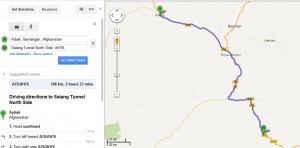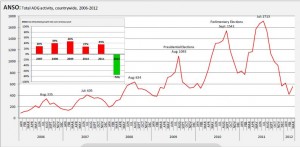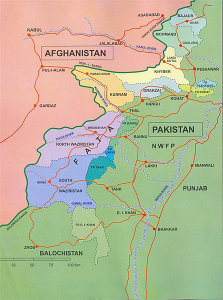Huge Backlog Remains in Karachi for NATO Supplies; Driver Killed Near Peshawar
The Express Tribune reports today that despite the fact that the NATO supply route through Pakistan reopened three weeks ago, the huge backlog of thousands of trucks at the port in Karachi has still not yet seen the first truck leave. The trucks that are moving along the supply route at this time are those that were at or close to the border at the time of the closing. We also learn that today marked the first attack on a supply convoy inside Pakistan since the route reopened, with one driver being killed by gunmen.
The number of trucks and cargo containers waiting in Karachi is huge:
The ban on Nato supplies routes through Pakistan may have officially been lifted three weeks ago but the containers carrying goods for international forces stationed in Afghanistan remain stranded at the Karachi Port Trust (KPT).
/snip/
“There has been no clearance of Nato cargo at KPT so far, but we expect the process will begin in the current week,” Hayat told The Express Tribune adding there was no hindrance on the part of the KPT as consignees needed to get their cargoes cleared from the customs department.
There are 3,851 vehicles and 1,983 containers belonging to Nato currently stranded at the KPT.
NATO owes a large bill for storage during the long closure of the route:
When the supply routes were resumed some three weeks ago, port authorities expected to receive up to Rs2.2 billion from Nato for storing its containers and vehicles for an extended period of time. Known as demurrage charges, the expected amount has now exceeded Rs2.5 billion, according to Hayat.
Meanwhile, a small convoy of trucks was attacked near Peshawar:
Gunmen in the outskirts of Peshawar Tuesday attacked a container truck carrying supplies to Nato troops in Afghanistan, killing the driver, officials said.
/snip/
Tuesday’s attack took place near the market in Jamrud town on the outskirts of Peshawar, the main city in the troubled northwest, local administration official Bakhtiar Khan said.
“Two armed men riding on a motorbike opened fire on a container carrying supplies for Nato troops across the border and killed its driver,” Khan told AFP, adding that the driver’s helper was seriously wounded.
Another administration official said the truck was part of a convoy of three or four vehicles travelling without security protection when they came under attack.
Although they have not yet claimed responsibility, it seems likely the Pakistani Taliban carried out the attack:
However, the Pakistani Taliban had threatened earlier to attack the supply trucks and kill its drivers if they tried to resume supplies to troops in Afghanistan, and right-wing and extremist religious groups have held large demonstrations against the resumption of supply lines.
Tehreek-i-Taliban Pakistan (TTP) spokesman Ehsanullah Ehsan had told AFP that the Taliban “will not allow any truck to pass and will attack it,” hours after Pakistan confirmed it had decided to reopen vital Nato supply routes into Afghanistan which have been closed since November.
“We will not only attack the supply truck but will also kill the drivers (of Nato supply trucks),” Ehsan had said.
Clearing the backlog from Karachi and getting the supplies through Pakistan into Afghanistan is looking like it will be a very long, expensive and dangerous process.



